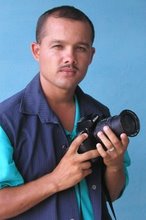
 Santiago de Cuba, for 28 years in a row now, plays host, together with Cuba’s easternmost province of Guantanamo, to the outstanding and peculiar cultural diversity from the Caribbean countries in a Festival to honor one of its members by dedicating the yearly celebration. Mexican states off the Caribbean's coasts are paid homage this time: Tamaulipas, Veracruz, Campeche Wood, Tabasco, Quintana Roo and Yucatán.
Santiago de Cuba, for 28 years in a row now, plays host, together with Cuba’s easternmost province of Guantanamo, to the outstanding and peculiar cultural diversity from the Caribbean countries in a Festival to honor one of its members by dedicating the yearly celebration. Mexican states off the Caribbean's coasts are paid homage this time: Tamaulipas, Veracruz, Campeche Wood, Tabasco, Quintana Roo and Yucatán. “The Caribbean People’s Cultures, defended and enhanced by the Festival, are, according to late Joel James (founding Director of the Festival), the spirit's area, where sovereignty of nations settles down.” said Orlando Vergés, director of the House of the Caribbean in the inauguration ceremony.
“The Caribbean People’s Cultures, defended and enhanced by the Festival, are, according to late Joel James (founding Director of the Festival), the spirit's area, where sovereignty of nations settles down.” said Orlando Vergés, director of the House of the Caribbean in the inauguration ceremony. 





 Internacional Congress on Peopl's Cultures .
Internacional Congress on Peopl's Cultures . 

The Monument to the Cimarron, by artists Alberto Lescay, seems to raise the slaves’ decision to achieve freedom.
 El Cobre town yields tribute to slave’s rebelliousness, a tradition rooted in our national culture itself.
El Cobre town yields tribute to slave’s rebelliousness, a tradition rooted in our national culture itself.
The ballet company from Santiago set the difference off.
 Next edition of the also known as the Fire Party will be dedicated the people’s cultures from Honduras
Next edition of the also known as the Fire Party will be dedicated the people’s cultures from Honduras Cuban and Mexican Trova music united in Eliades Ochoa and Mexican singers.
Cuban and Mexican Trova music united in Eliades Ochoa and Mexican singers.
A Guateque campesino is a party where traditional music is danced and creole food is eaten.





 Yolanda Rodríguez, photographer of the !Ahora! Weekly, won third prize with the series “When Little Armando Played to Be a Teacher”, a work standing for a photographic discourse without being afraid to let photography reveals itself as such, according to the members of the jury.
Yolanda Rodríguez, photographer of the !Ahora! Weekly, won third prize with the series “When Little Armando Played to Be a Teacher”, a work standing for a photographic discourse without being afraid to let photography reveals itself as such, according to the members of the jury.

 His steady hand holds up the scissors. His sight, 20x20, can not be better. He has never worn eyeglasses. Some neighbors have him help threading needles. The oldest active barber in business in Cuba; maybe in the whole world, but it is difficult to say.
His steady hand holds up the scissors. His sight, 20x20, can not be better. He has never worn eyeglasses. Some neighbors have him help threading needles. The oldest active barber in business in Cuba; maybe in the whole world, but it is difficult to say.









 Making pictures is a pleasure that enriches life "stated Jorgen Goomy. Do you share this statement?
Making pictures is a pleasure that enriches life "stated Jorgen Goomy. Do you share this statement?


















